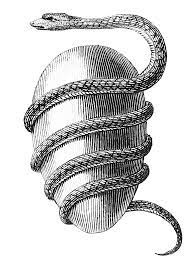Eurynome and Orphion:
The Mysteries of Creation and the Serpent’s Cult
In the rich tapestry of Greek mythology, amidst the pantheon of gods and goddesses, Eurynome and Orphion stand as enigmatic figures. They stand as a separate but equally important myth of cosmic creation and birth of the Greek Pantheon. From the cosmic dance of Eurynome, to the serpent Orphion and the divine egg, these divine entities show a different side to the Greek Creation myth we thought we knew.
The Cosmic Dance of Eurynome:
Eurynome a goddess known as a swan, as a dancer, and mother to all. One version of the creation myth has her as a primordial deity that danced out of the void of chaos and became the first being in existence. Her movements gave birth to the winds and the elements that make up our world.
In another version she was a Titaness and daughter of the primordial gods Oceanus and Tethys who emerged from the primordial chaos. She embodyed the concept of creation and cosmic order. Some versions of Greek myth do indeed have Oceanus and Tethys as the parents of the titans before the rise of the Olympians.
In the Orphic tradition, Eurynome plays a pivotal role in the creation myth, dancing upon the chaotic waters that enveloped the early universe. One such myth sees her as a swan of creation dancing and once more creations the elements. In her rhythmic movements, she shaped the cosmos, establishing the foundations of the natural world. Her dance symbolized the harmony and balance required for the orderly existence of the universe.
Orphion, the Serpent of Chaos:
Orphion, also known as Ophion, is a serpent deity often associated with Eurynome in certain creation myths. According to these myths, Eurynome and Orphion coiled around each other in a cosmic embrace, symbolizing the union of creative and chaotic forces. Option was the serpent as Eurynome was the swan, together they mated and the swan laid a great egg which Orphion coiled around until all of creation burst forth.
In some versions, Orphion is cast as a powerful and wise serpent who ruled over the cosmos alongside Eurynome. Their union is integral to the generation of cosmic energies that shaped the world. However, this union also foreshadowed a conflict that would lead to a new order.

The Cosmic Conflict and the Birth of Zeus:
The myth takes a dramatic turn when Zeus, the king of the Olympian gods, enters the scene. The family tree here is complex. Depending on which version of the myth you follow depends on where Zeus fits in. From Eurynome and Orphion the other primordials were born, then from Gaia other beings such as Uranus and the Titans eventually came to the scene and much of what we know takes place.
However, other versions show Orphion as an ultimate ruler of the cosmos. In this cosmic struggle, Zeus overthrows Orphion, casting him into the depths of the underworld. This act signifies the triumph of order over chaos, with Zeus assuming the mantle of cosmic ruler.
Zeus then mates with Eurynome, continuing the cycle of creation. From this union, the next generation of gods, including the Olympian deities, are born. The overthrow of Orphion marks the establishment of a new cosmic order, where Zeus reigns supreme. This would mean that Zeus would be the ultimate father figure adding many more titans, Olympians, and deities into his lineage.
The Orphic Cult and Mysteries:
The myths of Eurynome and Orphion are the base the Orphic tradition—a mystical and religious movement that emerged in ancient Greece. The Orphics believed in the purifying power of rituals, secret initiations, and the quest for divine knowledge.
Central to the Orphic beliefs was the concept of cosmic cycles, where the divine spark within individuals sought liberation from the cycle of reincarnation. Eurynome and Orphion’s myth played a crucial role in these teachings, symbolizing the cosmic forces at play in the eternal cycle of creation, destruction, and renewal.
Enduring Reverence and Interpretations:
Despite the fading prominence of ancient Greek religious practices, the Orphic cult’s influence endured through the centuries. The mystical aspects of the Orphic tradition continued to inspire philosophical and religious thinkers, with echoes of its teachings found in Neoplatonism and later esoteric movements.
In modern times, Eurynome and Orphion’s myths remain subjects of scholarly inquiry, drawing fascination from those intrigued by the mystical aspects of Greek cosmogony. Their stories continue to inspire artists, writers, and seekers of ancient wisdom, offering a glimpse into the profound mysteries of creation and the eternal dance of cosmic forces.
Conclusion:
The tales of Eurynome and Orphion transcend mere myth, delving into the profound mysteries of creation and cosmic order. From the primordial dance of the goddess to the conflict between the serpent of chaos and the lord of Olympus, their stories have left a mark on the spiritual and philosophical landscape. As the echoes of the Orphic cult persist through time, Eurynome and Orphion stand as symbols of the enduring quest for divine understanding and the eternal cycles that shape the cosmos.